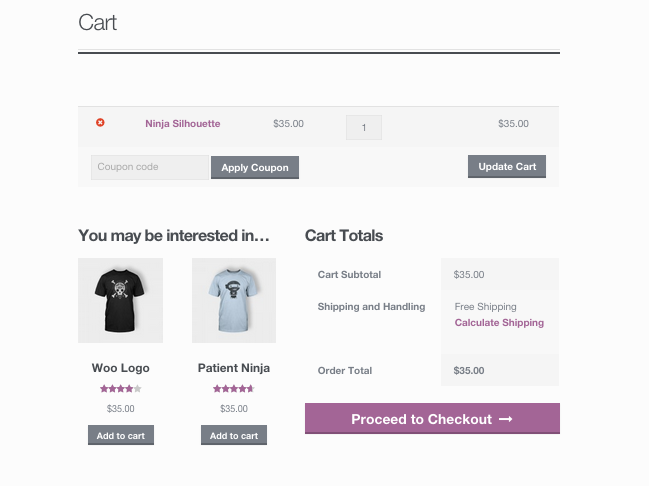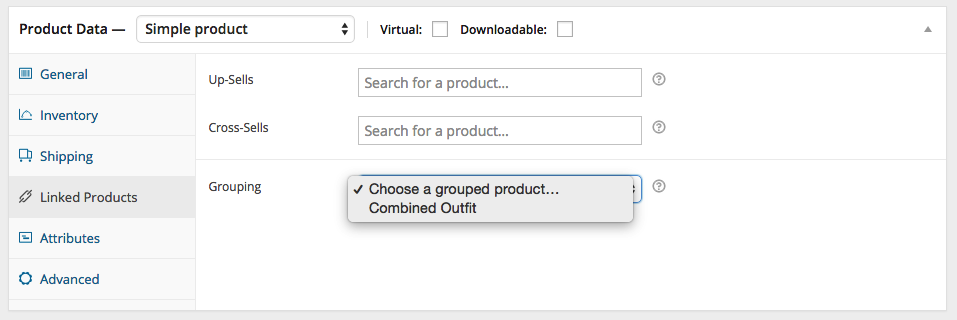Whether you’re just starting an ecommerce business or considering a rebrand, one of the most…
How to best suggest additional products to your shoppers

Once a shopper has decided on a product and added it to their cart, their first thought is going to be “great, now I’m ready to check out!”
At this same stage, your first thought might be “wait, don’t go yet! You haven’t even seen all my stuff yet!”
Motivating customers to purchase additional products is a challenge, but it doesn’t have to be. WooCommerce’s many solutions for suggesting, upselling, and bundling products together make it easy to show shoppers what else they should consider — and help you make more from every sale.
Let’s explore three of the best ways that you can add on to your customers’ purchases, from cross-sells to groups to bundles.
The flexibility of WooCommerce means you can package and promote products in multiple ways
We take pride in the flexibility of our platform. One of the things we love most about the collaborative effort behind WooCommerce is that it’s created tons of options for accomplishing almost anything — and this is no less true when it comes to upselling.
As this page in our docs shows, there are plenty of unique ways you can package and promote products. We don’t blame you for feeling confused by this list (sometimes we even question the best solution). But one of the best ways to sort out what to aim for is to think about what you’re trying to do.
If your goal is to get a shopper who’s considering a single product to potentially buy two (or more), you can eliminate several options from that list. What you’ll mainly want to look for are solutions that proactively suggest (but not force) additional products before or during the decision-making process.
Lucky for you, we’ve got a few of those. And plenty of them are built right into WooCommerce, so you can start doing them — and boosting your sales — without spending a dime.
We’re going to be focusing on three types of tactics in this post: cross-sells, Product Bundles, and Grouped Products. Read on to learn when you should use which solution, and how.
Why you might want to use a cross-sell
Cross-sells are products promoted within a shopper’s cart based on a product that has just been added. The functionality for cross-sells is available in WooCommerce right out of the box, so you can set them up as soon as you have a few products created.

You can set up cross-sells for products in WooCommerce by going to the Linked Products tab, then searching for the name of one or more products you’d like to suggest when that item is added to the cart.
Cross-sells are best used when you have data on what customers tend to purchase together, or which items customers tend to find complimentary. For example, if you sell shoes, you might know that shoppers buying a certain pair gravitate toward the same replacement laces, or seem to also like a similar pair in the same color.
By using cross-sells, you can use what you already know to make more sales, and show more shoppers products that they are likely to be interested in — and do so once they’re already thinking about making a purchase from your store, which is a big step on its own.

One thing to be mindful of with cross-sells: if you don’t have the data to support the products you recommend within the shopping cart, this tactic might not boost your sales much if at all.
For this reason, those running new stores might find one of the two options below a better choice.
When Product Bundles are the right fit
Product Bundles is an extension that we often recommend for its money-making potential: bundles of products at a discounted rate look appealing to shoppers, and they often lead to customers buying additional items they might not have otherwise considered.
The flexibility of Product Bundles is what makes it so appealing. Unlike cross-sells, the recommendation is made from outside of the cart — but in many cases, that’s a better time to do so.
For example, let’s say a shopper is looking at purchasing two new bath towels. They might perform a search and find that individual towels are $10… or they can purchase a bundle of two towels, a hand towel, and a washcloth for $25.
You can also recommend bundles from product pages. So if a customer wants to buy several towels in the same color, they might take a look at the related products (which, like cross-sells, are set up from the Linked Products tab) and spy a set of four towels at a discount.

The key to a successful bundle is often a discount, or at least some kind of perceived value. In the example we gave above, a customer would likely be willing to pay $25 for four products over $20 for two — even if they didn’t “need” the hand towel and washcloth — because they believe those two additions to be worth the extra $5.
You could also think about this from the standpoint of digital music. Single songs are often sold for $1, but you can buy the full album of 10-15 tracks for $8 or $9. That’s a prime example of a bundle being used to get you to buy more — and you might not have even realized it.
Let’s move on to one more option you might find useful for getting more products into carts.
Advanced recommendations with Grouped Products
Finally, let’s explore Grouped Products. Like cross-sells, you can group products in WooCommerce without any add-ons or extensions. This lets a shopper add multiple products from a range you define to their cart in one fell swoop.
These products don’t have to be purchased in a group — customers can still buy them individually. But the idea here is to set up the group so you have a better chance at selling more.
The first step here is determining which individual products you think will work best together. For example, you might want to allow a shopper to purchase multiple cupcakes at once rather than buying them all individually.

You’ll first set up a Grouped Product, then set up the child products that belong to it (if they don’t already exist). The child products will need to be grouped together, which allows them to appear on the same page.

Once your group is created, shoppers can choose which items from the group they’d like to add to their cart, whether it’s all of them, some of them, or none of them. So if you set up a group of each flavor of your cupcakes, a customer could pick two of one flavor, one of another, and five of another… or one of each.
Sell With WP has a great tutorial on grouped products which is helpful for understanding how they’re different than bundles, and when you might want to use them.
Not sure which suits you best? Consider what your store needs
As we mentioned toward the start of this post, it can be a bit confusing to sort out which method of upselling is going to suit your store best. But if you think about your needs, you can more easily make a choice.
You definitely want to sell more products. But are you aiming for this because your customers aren’t seeing everything you have to offer? If that’s the case, cross-sells might be the best fit, because they’ll help you get more products in front of your customers when they’re already interested in buying from you.
On the other hand, if your shoppers seem to already be aware of what you sell, but are only buying a few pieces — like two towels or a set of glasses — you can use bundles to encourage them to spend just bit more, while giving them the feeling that they’re saving a lot of money.
Use WooCommerce and its extensions to promote your products effectively
There you have it — three different ways you can suggest products to customers. Between cross-sells in the cart and groups on the product page, these tactics will give you the ability to boost your sales by using what you already have… that is, great products!
Have any questions for us about the difference between cross-sells, bundles, or Grouped Products? Or any thoughts of your own about this topic? We’d be happy to hear from you in the comments.
Read original article at Source link >
[wpseo_map width=”100%” height=”300″ zoom=”-1″ map_style=”roadmap” scrollable=”0″ draggable=”1″ show_route=”0″ show_state=”1″ show_url=”0″] [wpseo_address hide_address=”1″ show_state=”1″ show_country=”1″ show_phone=”1″ show_phone_2=”0″ show_fax=”0″ show_email=”1″ show_url=”1″ show_logo=”0″ show_opening_hours=”1″]


